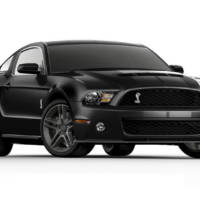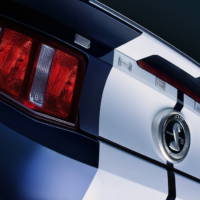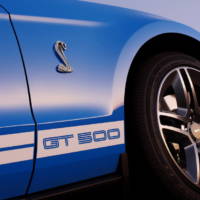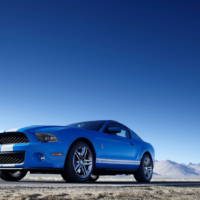The 2010 Ford Shelby GT500 was revealed today along with details and plenty of photos that you can feast your eyes on. The company sais that the 2010 Ford Shelby GT500 and its supercharged and intercooled 5.4-liter DOHC V8 engine that spits out 540 horsepower and 510 ft.-lb. of torque is the most powerful SVT-tuned performance Mustang ever. The numbers to back this statement up are 4.3 seconds taken to accelerate from 0 to 60 mph and the 12.5 seconds needed to cover a quarter-mile.
Designed to cope with the more powerful engine is the six-speed manual transmission that incorporates a twin-disk clutch system, and while the one through four gears are more performance-oriented, the fifth and sixth gears offer fuel economy. The 2010 Ford Shelby GT500 does 14 mpg in the city and 22 mpg on the highway, and Ford engineers mention that due to its improved aerodynamics this car has a near neutral coefficient even at speeds of 120 mph.
Details referring to the 2010 Ford Shelby GT500 price are yet to be announced.
Ford press release:
The new 2010 Ford Shelby GT500 delivers the most power and refinement ever for a Ford SVT-tuned performance Mustang – and a few surprises, too.
“The new Shelby GT500 demonstrates Ford’s continuing commitment to high-performance vehicles,” said Derrick Kuzak, Ford group vice president, Global Product Development. “In addition to the numerous performance and refinement improvements inside and out, it’s also two miles per gallon more fuel efficient on the highway.”
“We’re proud of the many enhancements jointly developed by the Ford and Shelby Automobiles team that we’ve incorporated into the new model,” said Carroll Shelby, founder of Shelby Automobiles. “Building on what we learned to create the Shelby GT500KR, this new car offers a great combination of power, handling and braking. It is truly a special car that is a great deal of fun to drive.”
Ford’s Special Vehicle Team used the gains made on the Shelby GT500KR “King of the Road” Mustang as the performance starting point and built from there. The design team, with a nod to the original Shelby Cobra from the 1960s, takes those design cues even further with nuanced improvements in both the coupe and convertible, each of which boasts a more-refined interior.
“Working together on the KR, the Ford and Shelby teams developed new systems to continually improve the iconic Mustang,” stated Amy Boylan, president of Shelby Automobiles. “Those lessons learned are incorporated into the 2010 Shelby GT500. This approach will help maintain Mustang’s leadership position and make the ownership experience even more enjoyable.”
“The muscle car segment is becoming even more competitive,” said Jamal Hameedi, chief nameplate engineer for SVT. “We need to uphold the Mustang badge with honor, the Shelby badge with honor and most importantly the Ford badge with honor. This is the car that will do all of that.”
More horsepower, more refinement, more functionality
The combination of added horsepower, refinement and functionality makes the 2010 Shelby GT500 a unique high-performance car. It delivers more horsepower and more torque than the outgoing model, thanks in part to advancements pioneered on the GT500KR.
The 2010 Shelby GT500 is powered by a supercharged and intercooled 5.4-liter dual overhead cam V-8 engine that produces 540 horsepower at 6,200 rpm and 510 ft.-lb. of torque at 4,500 rpm. The redline is 6,250 rpm. The car’s aluminum power dome hood not only adds to the Shelby’s appearance, it helps cool the engine through a hood extractor.
The Shelby’s open-element air induction system features a conical air filter instead of a flat-panel closed system to reduce air restriction. This approach allows more air to be pumped through the engine, producing more power and increasing the engine’s efficiency. A cold-air intake feeds the coolest air possible directly into the air box, helping further increase horsepower. The intake necessitated moving the Cobra snake badge to the other side of the grille to enable maximum airflow.
The twin-disc clutch on the six-speed manual transmission has been significantly upgraded, improving drivability and NVH. The discs on the 2010 Shelby GT500 are larger – 250 mm in diameter compared with 215 mm in diameter on the outgoing model – and made of copper and fiberglass to make them more robust. A unique component of the twin-disc system is the control of the intermediate disc. Rather than floating, it instead has six straps that control the engagement of the clutch, improving drivability.
The 2010 Shelby GT500 offers customers improved straight-line acceleration, plus fuel savings when cruising on the highway in the top gears. Gears 1-4 remain the same, but fifth gear changes from .80 to .74 while sixth gear goes from .63 to .50, meaning that the 2010 Shelby GT500 will turn lower engine RPMs in those gears and deliver improved fuel efficiency. The new final drive ratio, moving from 3.31 to 3.55, enables the improved acceleration in lower gears while complementing the revised fifth and sixth gear ratios.
The Shelby’s distinct sounds will be apparent as always, though with new refinements, thanks to the work of the Noise, Vibration and Harshness (NVH) team. A patented resonator placed between the air filter and engine throttle body helps keep unwanted noise in check.
“You still hear the supercharger but not so that it’s intrusive,” said Kerry Baldori, chief functional engineer for SVT. “It’s the same with the exhaust. You want people to know you’re driving something special, but you don’t want an exhaust note that overpowers the whole interior.
“We spent a lot of time getting the right sound quality out of the exhaust so you get that nice, crisp Shelby sound outside and a pleasant sound inside the cabin. It’s a nice balance; one isn’t overpowering the other,” said Baldori.
Driving dynamics also are improved, thanks to SVT’s signature chassis tuning as well as new 19-inch Goodyear F1 Supercar tires and forged aluminum wheels on the 2010 Shelby GT500 coupe and 18s on the convertible.
Springs and dampers have been optimized for better roll control, giving customers more confidence when braking, accelerating or turning. The new chassis tuning takes its philosophy from the KR program, with a greater emphasis placed on primary body control. The team also stiffened the steering shaft.
“All our changes were about making the car respond as fast and as predictable as possible,” Hameedi said. “The 2010 Shelby GT500 conveys an athletic, confident feel. The shifter, clutch pedal, brake-pedal efforts and overall steering efforts are easier now. We wanted to make sure we had a nice, crisp short-throw shifter that was easy to go from gear to gear.”
The Goodyear F1 Supercar 19-inch tires have been upgraded, too. SVT members developed a “recipe” for the attributes and characteristics they wanted in the tire, which Goodyear’s team of engineers, designers and manufacturers brought to life. The result is better grip, better handling and better NVH properties, leading to a better customer experience.
The wheels themselves complement the high-performance nature of the 2010 Shelby GT500. The 19-inch wheels are forged aluminum wheels milled on both sides. The extra machining process creates “blade” spokes with very thin, yet strong, cross-sections. The spokes have a specific curve from the rim to the hub, not only for strength, but also to accentuate the offset and width of the tires.
The 2010 Shelby GT500 features AdvanceTrac®, Ford’s stability control system, with several options for performance. The default “on” mode accommodates every-day driving, and a Sport mode delivers for those wanting to put the Shelby GT500 through its paces on the track. The system also can be turned completely off, although the anti-lock brake system and other active safety systems remain in place. Standard safety equipment includes dual stage front air bags, side-impact air bags and Ford’s Personal Safety System®.
Numerous aerodynamic upgrades, including a redesigned splitter, were made to the front end of the 2010 Shelby GT500.
The team worked hard to get as much downforce with as little drag as possible, said Baldori. They worked to seal off the air that comes in the front so it can’t go under the car. A lot of time also was spent sealing components such as the radiator and intercooler to get rid of all leak paths. The result is an increased downforce, reduced drag and improved overall efficiency of the vehicle.
Directing the air so it’s used most efficiently was a painstaking process that ultimately will be rewarding to customers. The design of the front fascia and the car’s “flush” hood helps focus air flow. The top grille focuses air into the radiator, with a rubber flap inside the engine compartment helping to seal the system. The lower grille helps cool the intercooler.
SVT engineers also went as far to block off specific diamonds in the front of the 2010 Shelby GT500’s distinctive grille to help maintain the correct cooling and aerodynamic balance.
A meaner, reskinned snake ready to take to the streets
The 2010 Shelby GT500 is the most-robust design and most-distinctive model of the new Mustang lineup. “The design we chose was a ‘flush’ hood where the fascia defines the entire front of the vehicle,” said Hameedi. “That’s very hard to execute from an engineering standpoint, but it really sets the Shelby off as very different from the base Mustang.”
“This epitomizes the ultimate Mustang,” added George Saridakis, exterior design manager of the Mustang and Shelby GT500. “It’s all about power and expressing power.”
Saridakis said his team took a cue from the Shelby AC Cobra 427 with respect to the front grilles, which are gaping and appear ready to swallow the road.
Another obvious difference for the Shelby is the addition of racing stripes, which also will now be available on the convertible. “Racing stripes made their mark on 1960s-era Ford performance vehicles,” Hameedi noted. “That’s something we feel is a key part of the Shelby performance DNA – maybe more so than some of our competition.”
Rounding out the Shelby’s exterior modifications are the unique signature coiled Cobra badges on the front grille and front fenders, a more aggressive front splitter and lower-drag rear spoiler, which added to improved aerodynamic features. The spoiler is raked back aggressively to minimize drag, while an integrated Gurney Flap provides the downforce.
What’s inside counts with the 2010 Shelby GT500
The base 2010 Mustang received a powerful new interior design. For the GT500, the interior design team members challenged themselves to raise the bar even higher to create the ultimate Shelby Mustang interior.
Using genuine materials such as real leather in all seats, real aluminum on the instrument panel and Alcantara® suede inserts on the seats and steering wheel gave the appearance a precisely crafted, jewel-like yet functional feel. Customers can select racing stripes on the seats that match the exterior stripes.
The genuine aluminum finish panels have a unique-to-GT500 three-dimensional dimpled texture pattern inspired by racing clutch plates, braided hoses and cross-drilled racing brake rotors.
The pattern has been painstakingly tuned to compensate for the compound curvature of the instrument panels. In addition, the “GT500” logo has been discretely engraved into the aluminum in front of the passenger as a nod to classic Shelby Mustangs of the 1960s.
This unique aluminum finish panel is fully encapsulated by an exquisite soft seamless TPO (Thermoplastic Olefin) instrument panel with a shape that resonates with Mustang’s powerful heritage. The center stack flows into the console and features a sub-flush shifter trim ring, flush cup holder door and lockable console stowage featuring the word “SHELBY” engraved in its Satin Liquid Chrome release button.
All 2010 Mustangs and Shelbys feature bright 360-degree rings surrounding the gauge cluster, uninterrupted by the steering column. These rings will come in chrome for the Mustang and a Satin Liquid Chrome finish for the GT500. This finish is featured throughout the interior. An intricate cobra is etched into the center of the aluminum steering wheel badge. The Shelby Cobra appears at startup on the navigation screen, and the familiar red “SVT” logo utilizes new ambient lighting to illuminate the door scuffplate.
“When customers drive this car, they’re not only going to be impressed by the performance and the Shelby heritage, but they’re going to see all these carefully designed details and know they’ve bought a well-crafted car,” Saridakis said.
Even the classic white shift knob – an icon of Shelby Mustang DNA from years past – received special attention. First, it had to be the traditional white. It also had to be specific to the Shelby. The answer was to combine the racing-stripes theme with the traditional “H” pattern found on shifters to create a one-of-a-kind knob. Like the exterior, the racing stripes wrap from end to end, encircling the knob.
Wide suite of standard features on the 2010 Shelby GT500
The 2010 Shelby GT500 includes several Ford innovations and industry-exclusive standard features, including:
– SYNC: The voice-activated hands-free in-car communication and entertainment system developed by Ford and Microsoft. The system fully integrates most Bluetooth-enabled mobile phones and digital media players, providing customers hands-free cell phone and music selection capabilities – plus new 911 Assist and Vehicle Health Report provided with no monthly fees.
– 911 Assist: When a phone is properly paired, turned on and connected to SYNC, the system is ready to assist in placing a call directly to a local 911 emergency operator in the event of an air bag-deploying accident. The key advantage of SYNC 911 Assist is speed, as calls are placed directly to local 911 operators.
– Vehicle Health Report (VHR): SYNC gathers relevant information from the major vehicle control modules and packages diagnostic data into a usable format in a matter of minutes. That data packet is sent to Ford via an 800-number automatically dialed using the customer’s paired and operable mobile phone.
– Ambient Lighting System with MyColor™ allows drivers to customize the interior lighting of the vehicle to suit their mood. The enhanced MyColor system features seven base colors – ice blue, purple, blue, orange, red, white and green. Customers also can create 125 custom colors by mixing the red-green-blue palette.
Available options:
– Voice-Activated Navigation with SIRIUS Travel Link™ is an industry-leading technology that provides users a unique, information-rich in-car experience. The suite of data services includes up-to-the-minute real-time traffic data with accident and incident information for 78 markets, coast-to-coast weather data including current conditions and five-day forecasts and fuel price information for more than 120,000 gas stations. SIRIUS Travel Link also offers sports scores and schedules and a listing of more than 4,500 movie theaters with movie times, theater addresses, movie synopses and more.
This combination of outstanding performance coupled with a fresh, exciting, well-crafted interior intensely focused on improving the entire experience will make the 2010 Shelby GT500 even more sought after, and a fitting addition to a long and proud history.
The 2010 Shelby GT500 will be in dealer showrooms in spring. The cars will be built at the Auto Alliance International Plant in Flat Rock, Mich.
“Better” is the operative word when describing the 2010 Ford Shelby GT500. Better horsepower. Better torque. Better handling. Better interior.
And, yes, better fuel economy.
“The 2010 Ford Shelby GT500 picks up an additional 40 horsepower and 30 ft.-lb. of torque over the outgoing model, and has better fuel mileage as well,” said Kerry Baldori, chief functional engineer for Ford’s Special Vehicles Team. “That’s a huge win-win for our customers.”
Certification testing shows the 2010 Ford Shelby GT500 improves 2 mpg in highway conditions compared to the outgoing model, with ratings of 14 mpg city and 22 mpg highway. Changes to the top gears, which were made taller, are a key reason for the improvement.
Refinements to the supercharged and intercooled 5.4-liter DOHC V-8 engine’s calibration and improvements to the cold-air intake system help increase the performance on the 2010 Ford Shelby GT500. The engine calibration now features a dual-knock sensor system instead of a single-knock sensor, improving the efficiency of the engine by making better use of the fuel provided. The cold-air intake system makes sure cold air is directly fed to the engine under all circumstances, whether on the street or on the track, to give customers maximum power. The redline is 6,250 rpm.
“Where you really feel the new power and torque is mid-range,” said Baldori. “The new Shelby GT500 produces more torque than the outgoing model at 3,000 rpm and never looks back.”
Gains made on the special 40th anniversary edition Shelby GT500KR’s cold-air induction system are part of the 2010 Ford Shelby GT500’s package as well. Attention was given to the hood blanket to form a tight seal in the area around the induction system and open air filter element.
The additional power in the 2010 Ford Shelby GT500 is easier to handle thanks to improvements to the twin-disk clutch system on the 6-speed manual transmission. The twin disks are a larger diameter – up from 215 mm to 250 mm – are more robust and now made of copper and fiberglass.
“If you went with one disk, the torque output of the 2010 Ford Shelby GT500 would require that disk to be very large,” said Baldori. “The twin-disk system allows us to get the required surface area in a smaller package. Having two disks also lowers the inertia compared with one large disk, which improves drivability.”
The intermediate disk, rather than floating, has six straps that control the engagement of the clutch, improving drivability, and a dampener reduces gear clash and gear rattle noises. The overall result is that clutch efforts are dramatically lower while clutch engagement is smoother.
“The ability to launch is much easier,” said John Pfeiffer, product development engineer. “You can jump in the 2010 Ford Shelby GT500 and rip off 4.3 (0 to 60 mph times) without any practice, on your way to a 0-100 time of 9.4 seconds.”
When not on track, customers of the 2010 Ford Shelby GT500 will benefit from improved highway fuel mileage after improvement to the six-speed gearbox. Fifth gear changes from .80 to .74 while sixth gear goes from .63 to .50. “Our final drive ratio went from 3.31 to 3.55,” said Pfeiffer. “That extra power, torque and gear ratio makes gears one through four more performance-oriented, while fifth and sixth gears gives you fuel economy.”
The 2010 Ford Shelby GT500, with more horsepower and torque than the outgoing model, is definitely faster on the road and on the track.
Faster responding, too.
Ford’s Special Vehicles Team used advances pioneered on the Shelby GT500KR “King of the Road” Mustang to improve the driving dynamics of the 2010 Ford Shelby GT500. SVT engineers lowered the chassis and worked to reduce the ride heights while also stiffening the coupe and convertible to improve the overall body control, roll stiffness and roll gradient (how much the car rolls).
“What we came out with was a chassis that feels more controlled and reacts faster,” said Kerry Baldori, chief functional engineer for SVT.
The front damping and spring rates on the 2010 Ford Shelby GT500 were increased and share the same setup on the front end as the KR. Overall, the goal with the 2010 Ford Shelby GT500 was to maintain the high-performance attributes of the KR, but in a more-refined manner.
“We focused most on improving the steering and dry handling attributes because they are the ones that matter most to the customer,” said Andrew Vrenko, vehicle dynamics engineer. “We wanted to give the steering more feel and have the car really feel as if it’s more connected to the road.”
The 2010 Ford Shelby GT500 delivers with a high-performance vehicle that is substantially improved in terms of aerodynamic balance, which customers who take their Shelbys to the track will immediately notice and appreciate.
“Using data from the wind tunnel and the track, the new Shelby GT500 is near neutral at 120 mph – it makes about 20 pounds of lift,” said John Pfeiffer, product development engineer. “This is 50 percent better than the KR and 75 percent better than the outgoing model.”
SVT also managed to reduce the downforce on the rear by 50 percent compared with the outgoing model as it worked to reduce drag and maximize balance. The new Shelby GT500 reacts the same at 120 mph as it does at much lower speeds because the center of gravity doesn’t change from aerodynamic forces as you get up to speed.
The coupe adds 19-inch bright machined aluminum wheels as a standard feature. In addition to the larger wheel, SVT worked with Goodyear to help upgrade the F1 Supercar 19-inch tires to improve grip, handling and NVH properties.
One of the new tunable components on the new Shelby GT500 is the addition of a wicker bill or “Gurney Flap” on the rear. Introduced by racing legend Dan Gurney nearly 40 years ago, the Gurney Flap is essentially a tunable element on a low-drag spoiler. On the 2010 Ford Shelby GT500 it sticks up about 6 mm and is positioned at a right angle to help create downforce. Tuning options include using Gurney Flaps of different heights or removing it altogether.
From the track to the highway, the 2010 Ford Shelby GT500 gives drivers all the performance improvements of the KR: maximum lateral acceleration; the fun-to-drive aspects; the 0-60 time (4.3 seconds) and, the quarter-mile time (12.5 seconds at 116 mph).
“These are all the attributes that customers want in an on-the-edge performance car, but we’ve also delivered a comfortable daily driver as well,” said Baldori.

31 Mar 2009
0





































